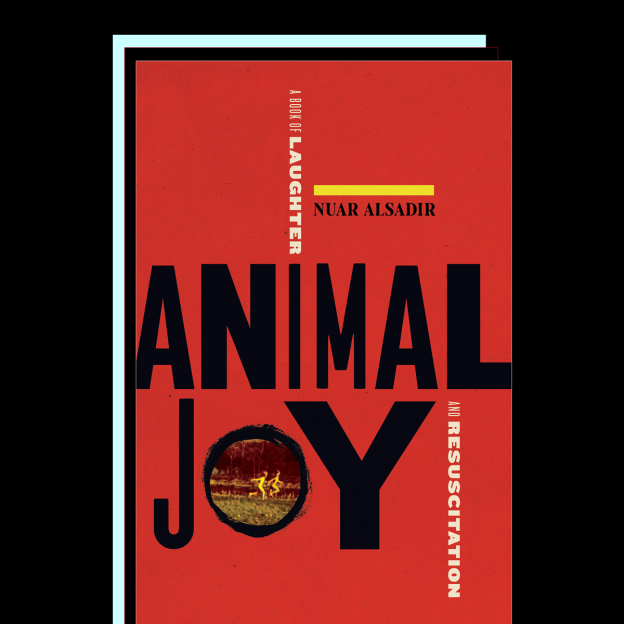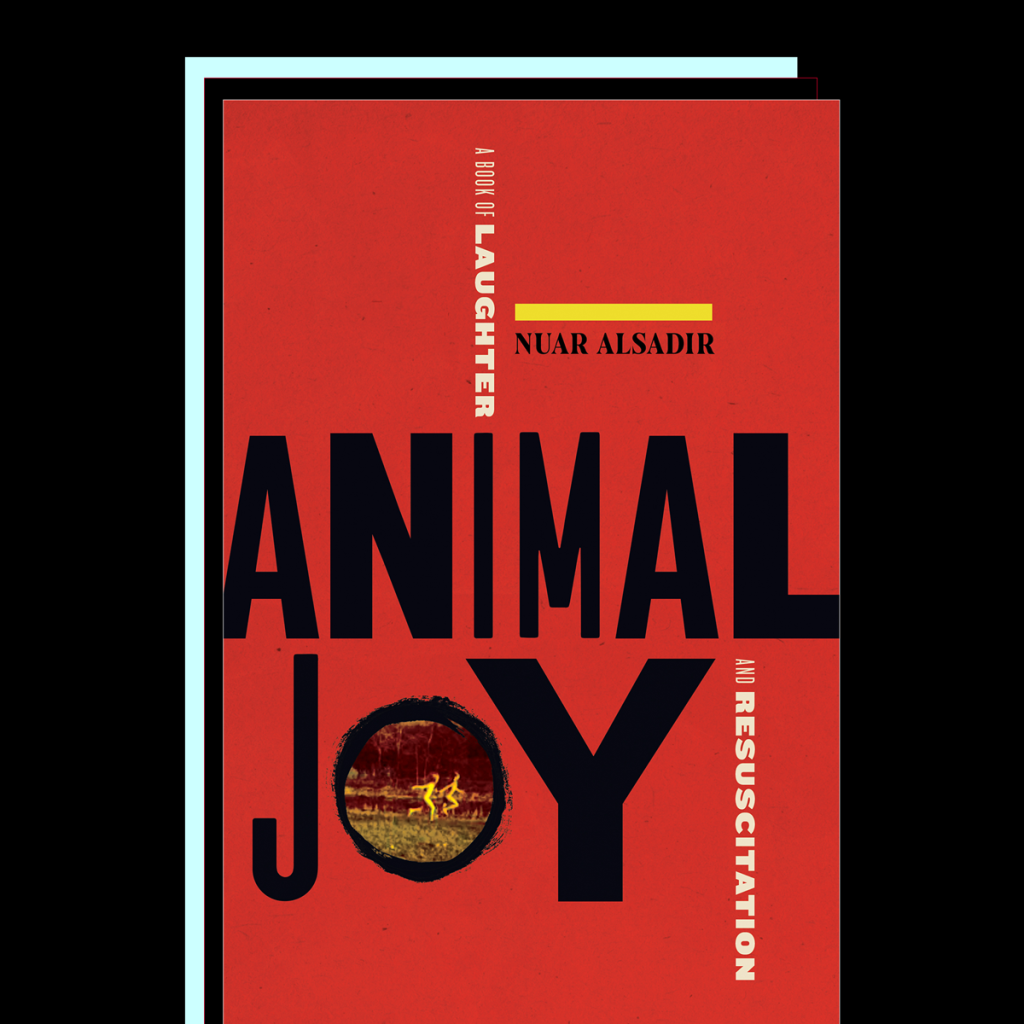
Animal Joy — Nuar Alsadir
by
“Corpsing,” a term with origins in the theatrical stage, refers to the phenomenon where a performer breaks character (traditionally a dead character, the eponymous “corpse”) through laughter. The laughs are unscripted, uncalled for, the ur– “un” that upends the agreement between performer and audience. You’re dead and lovin’ it, the break severing all pretense of a tentatively signed social contract. Outside the world of theater, the experience of corpsing, more broadly laughter itself, comes to us as an anarchic force. Laughter destabilizes, it upsets, it’s the friction that makes us so loudly, vocally human.
Nuar Alsadir’s Animal Joy implicitly poses the question, what does it mean to laugh? Through a tumbling, poetic lens of psychoanalytic research, free association, and personal narrative, Alsadir asks how jokes––their manifold catalysts and meanings––both make, touch, and reshape our humanity. Consider this now: an outburst of laughter, according to Freud, “is an eruption from the unconscious—a discharge of surplus energy—and, like a sneeze, cough, hiccup, or slip of the tongue, has the potential to expose raw, unedited aspects of a person’s interior”. There’s a vibrant sense of play coursing through Animal Joy, a sensation akin to analyst D.W. Winnicott’s conception of play as essential to human growth, a space for new understandings, new potentials for the self and other—potentials for something unknown.
Let’s follow Alsadir’s lead. As an undergraduate student I was in an exchange program called Oxbridge. I lived with three other American students in a shotgun row house by a milky curve of the Thames and a methadone clinic. My days were spent running in the park behind the house and haphazardly attending tutorials. The park was a site of many firsts, ripe for analysis: it is the field where I began my hobby of wildflower identification, the bridge where I saw a severed pig’s head in a public space, the abandoned train tracks where I broke dishes, the forest where I never felt so lost, and the muddy path where I first saw a man masturbate. One day after a morning run, I came back to the house with a fistful of flowers for the bathroom. I set the flowers near the open window and got ready to take a shower. I then lifted the toilet seat to find something I had also never seen. The toilet bowl was filled to the brim, the water level nonexistent, with human feces.
Now reader, you might think I’m indulging in hyperbole, shit both literal and metaphorical as the punch line. You’d be incorrect. There was no plunger, no socially acceptable way to handle the domestic disaster that had just befallen my only washroom. Fifteen minutes passed and I found myself armed with an exceptionally large bottle of body wash and an errant bag of bar soap. The toilet becomes unclogged. A new disaster: what to do with the bottle and bag dripping with excrement? I spied the open window and open rubbish bin two stories below. I was overtaken by uncontrollable, hysterical laughter, as I concluded as one only can at twenty years of age. I laughed wildly as my throw missed the trash can. Shit and soap rained down upon the English countryside. What can you do when the exterior blends with the interior, when the impenetrable becomes naughtily penetrated? I laughed, I laughed, I laughed.
Author Milan Kundera’s first novel The Joke is about the power of words, of laughter, of humor, to destroy, to provoke, to ruin under censor. The titular joke, made by the main character, is used as a weapon against his livelihood; he is expelled from school and the opportunities available to him quickly shrink, till he finds himself alone and bereft under the censorious rule of a communist Czechoslovakia. Like Alsadir writes on Donald Trump’s tenure in the White House, “power in politics, as in jokes, hinges on the politician’s ability to reframe or pervert reality.” Any self-interest or personal agenda of the joke’s teller, the public servant, must then be retooled, repackaged, rebranded under structures of capital. This ability to puncture, to bother or delight, originates within the unconscious. The successful comedian and the powerful politician—both possess the skill to speak at the level of affect, to engage the codex of the unconscious.
Yet, engaging the unconscious is far from simple. As Animal Joy details, laughter is savage, laughter is complex, laughter is an engine for eros and thanatos. A laugh is the friction between the social codes which govern public behavior and the private neuroses and perversions that form a Lacanian grammar of personhood. Alsadir’s narrative threads anecdotes of their time training in the Lecoq school of physical theater with the work of Freud, Bataille, Lacan, Winnicott, and numerous other thinkers, to present psychoanalysis as the critical framework by and through which the shadings of a laugh, of a person, can begin to be gleaned, to be seen, and to possibly be known.
Duchenne laughter is named after the nineteenth-century scientist Guillaume Duchenne who mapped the musculature of the human face. The expression has become shorthand for a genuine laugh, one where the eye muscles move in coordination with the mouth. Alsadir’s work is itself Duchenne. Animal Joy presents the abundance of a life; in its disappointments, its traumas, its wanderings, and its delights, there lies the possibility of recognition, the knowledge that you and I are sharing an impossibility, inanity, knowledge, and physicality. We’re in on the joke.
ANNETTE LEPIQUE reviewer
Annette LePique is an arts writer and educator based in Chicago. Her research interests include cinema, race, time, hysteria, and the ill body. She has written for Cleo Film Journal, Another Gaze Feminist Film Journal, is a frequent contributor to Chicago Artist Writers, and a Features Writer at Sixty Inches from Center. She has presented work in Montreal and Los Angeles.

Alsadir, Nuar. Animal Joy: A Book of Laughter and Resuscitation. Graywolf Press, 2022.
© Copyright for all texts published in Stillpoint Magazine are held by the authors thereof, and for all visual artworks by the visual artists thereof, effective from the year of publication. Stillpoint Magazine holds copyright to all additional images, branding, design and supplementary texts across stillpointmag.org as well as in additional social media profiles, digital platforms and print materials. All rights reserved.